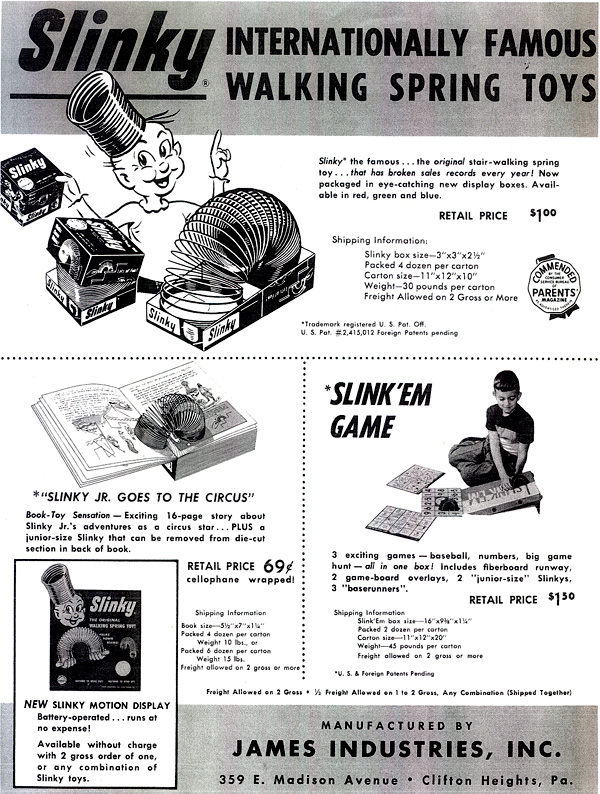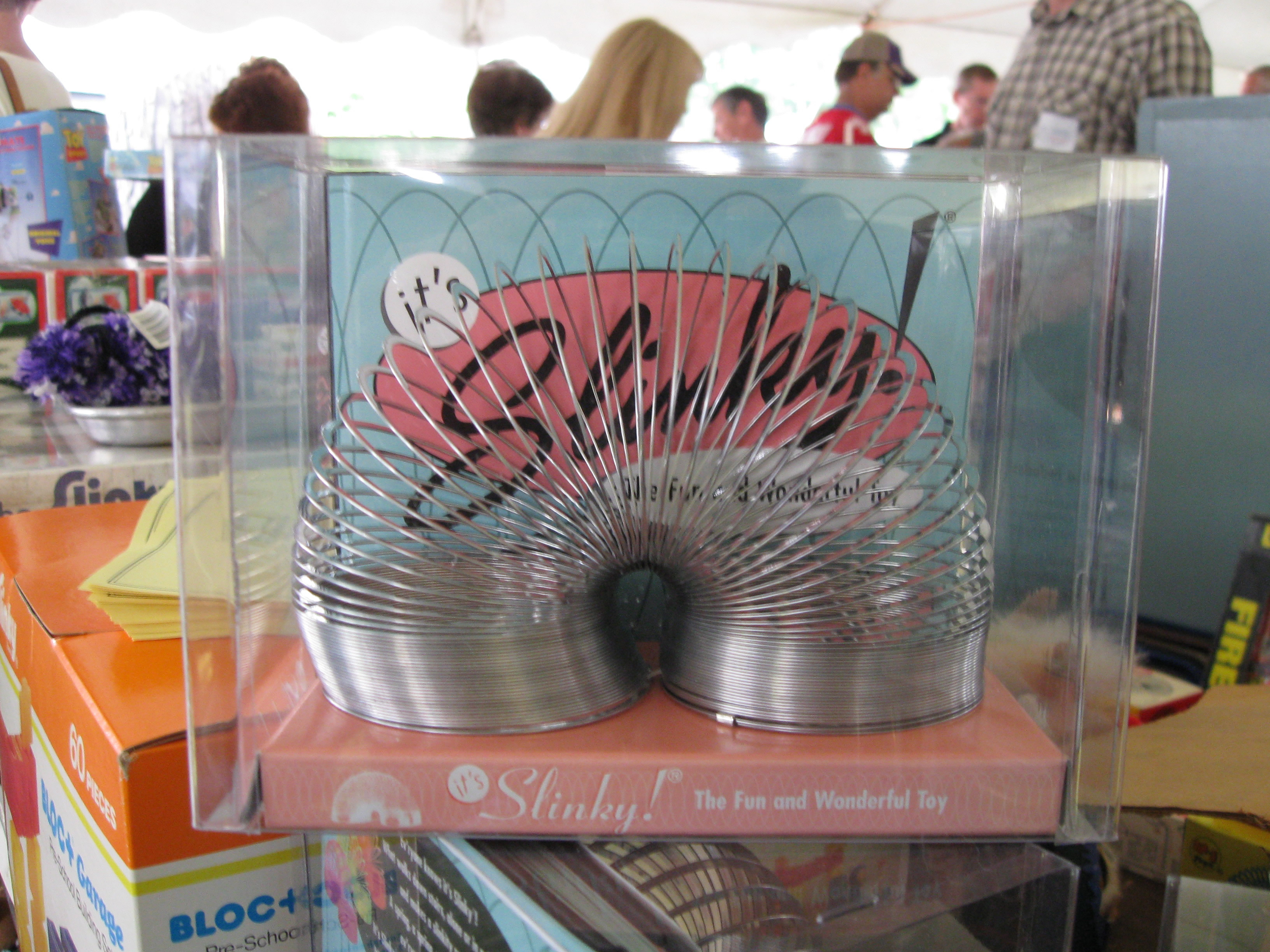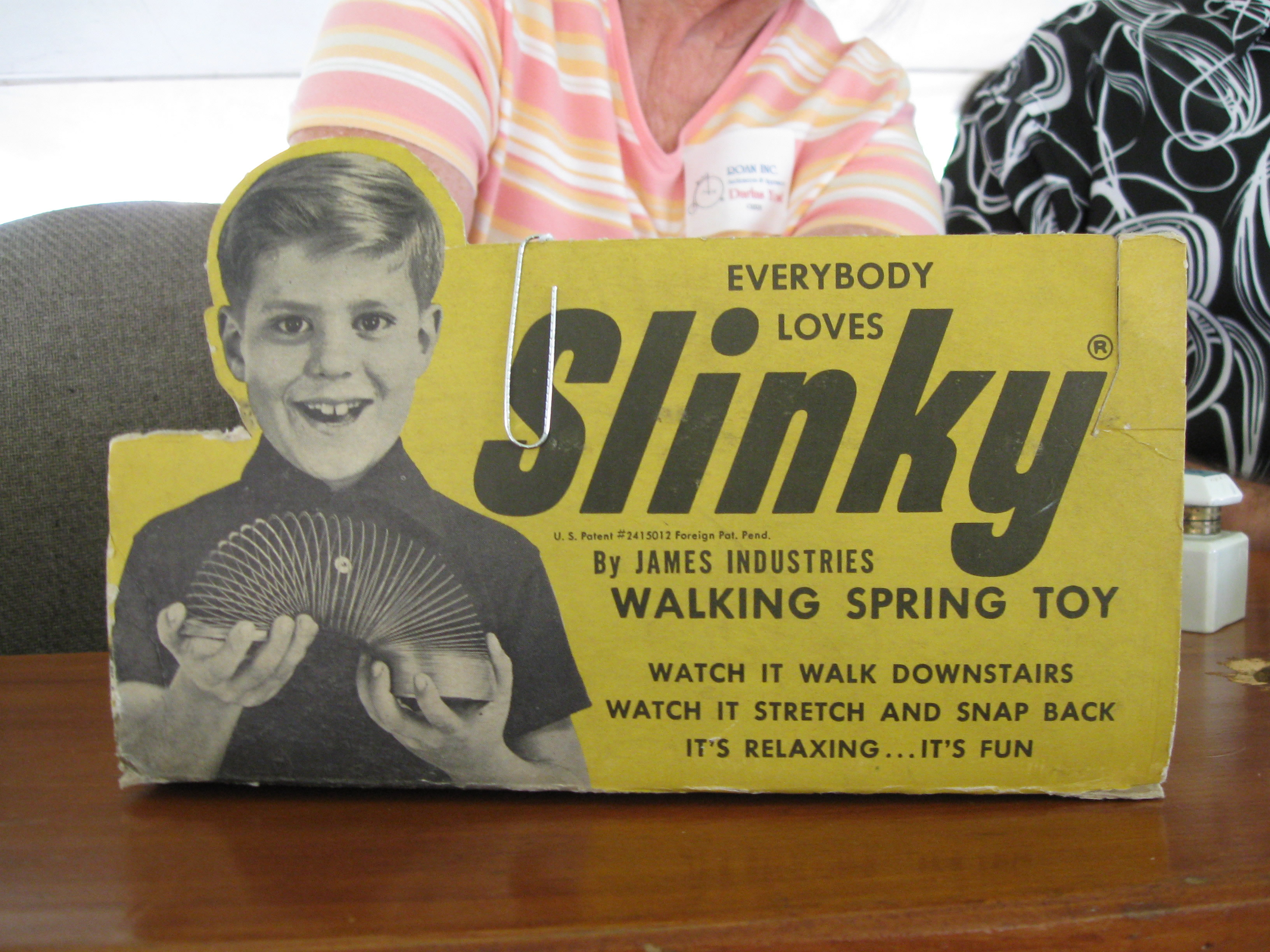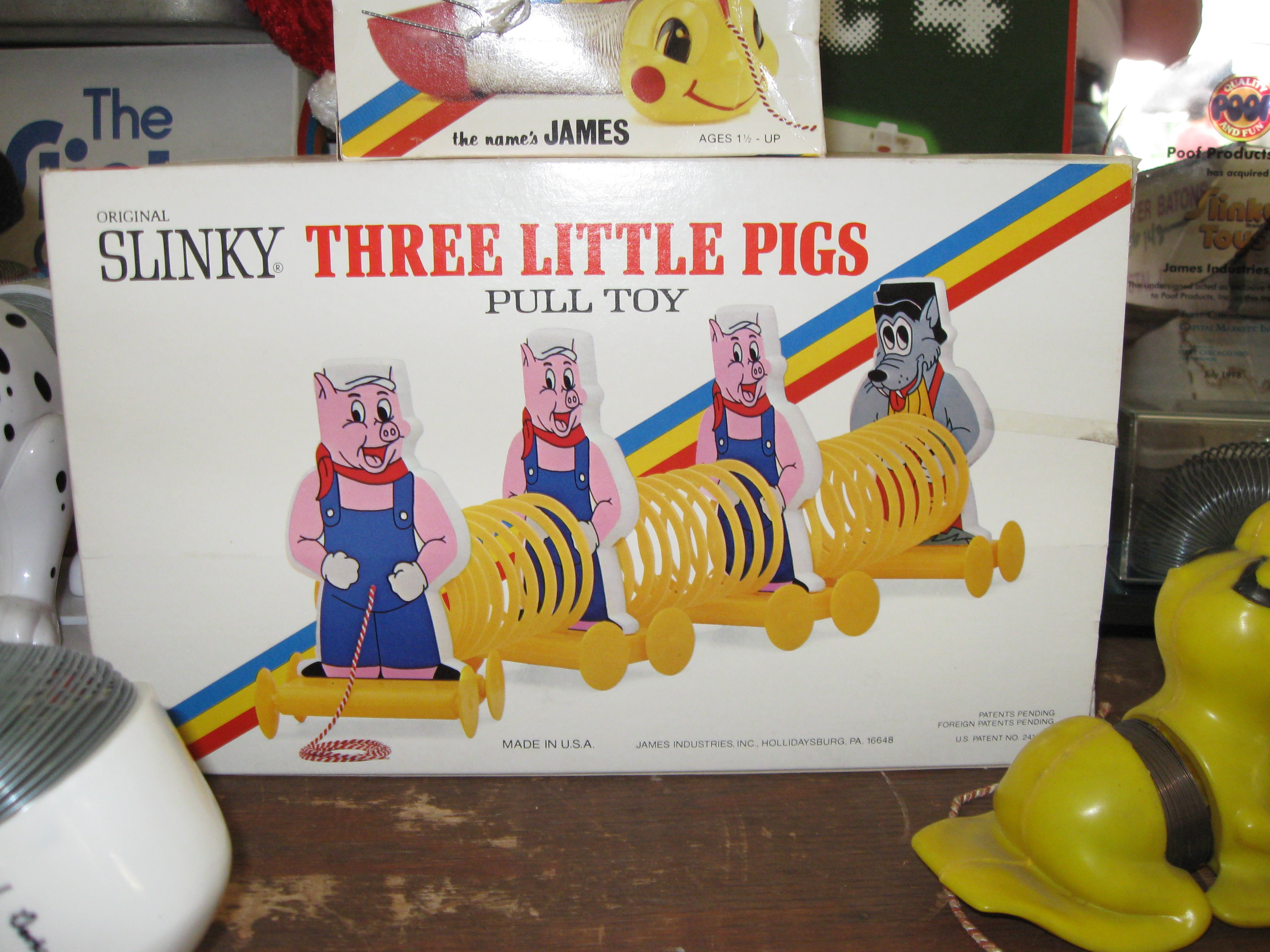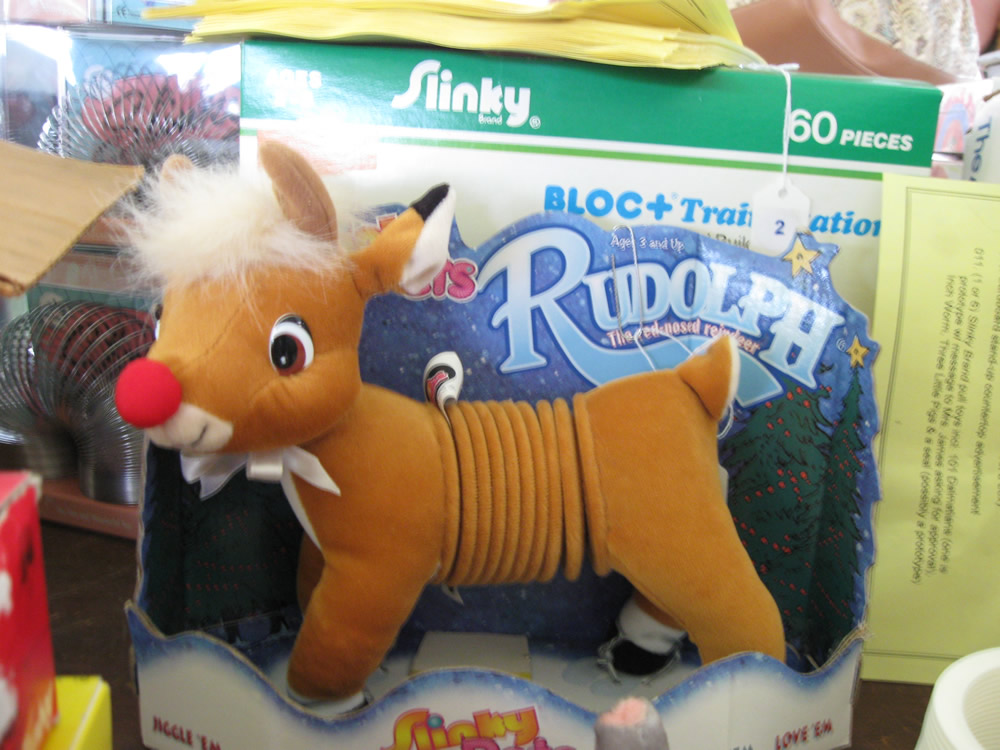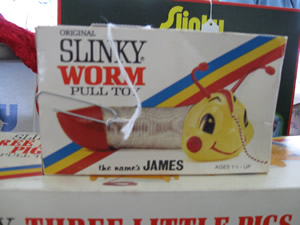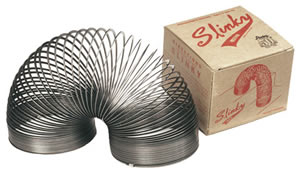
The most famous story of gravity and scientific inspiration is that of Isaac Newton and his apple. Legend has it that when Newton saw an apple fall, he was struck by a divine idea — something must make the apple fall straight toward the ground. That something was gravity. Newton would go on to physics glory and the apple incident would become required myth for schoolchildren for years to come.
Well, another inventor shares inspiration with Newton. Not a falling apple, but a falling spring sent his mind whirling and started a iconic toy that has survived for more than 50 years.
Richard James was hard at work. As a naval engineer during World War II, he had been charged with the task of insulating shipboard instruments from shocks and vibrations. While experimenting with tension springs, one of his springs fell to the floor and began to move in the characteristic walk of what we now know as the Slinky. James was intrigued. Later, he took showed the spring to his wife, Betty, and the two set about crafting what would become the springy, stair-walking toy.
In 1945, the pair made their way to Gimbels Department Store in Philadelphia, Slinkies in tow. The Jameses were nervous about the financial prospects for their new invention. In the store, they demonstrated the Slinkies' ability to "walk." Customers were hooked. The James's had brought 400 Slinkies. Within 90 minutes, they were sold out of the $1 toys.
They had a hit on their hands. More plans followed. To manufacture Slinkies (Betty James' name; it means "stealthy, sleek and sinuous" in Swedish), the couple founded James Spring & Wire Company (later called James Industries) in Clifton Heights, Pennsylvania. Richard James created machines that could change 80 feet of Swedish wire steel into a Slinky, all two and a half inches and 98 coils of it. Advertisements for the Clifton Heights factory show other products: a pull-toy Slinky train, a "Slink'Em Game" that let users play baseball, numbers and big game hunt and a motorized Slinky display. The Slinky brand had a home. Then came 1960.
1960 was a memorable year, Betty James would tell the New York Times in 1996. That year, her husband Richard left Philadelphia for Bolivia with a religious group. With six kids to support and a fledgling business to support them on, Betty James had to make a decision.
This is how she told it to the New York Times reporter: "The children then were ages 2, 4, 6, 8, 16 and 18. So, no, I wasn't interested in South America. When we first had Slinky, we got a lot of publicity, made a lot of money, and he just didn't handle it well. He thought he was big time. And these religious people always had their hands out. He had given so much away that I was almost bankrupt. I sold the factory and decided to move from the Philadelphia area back to Altoona, where I grew up, with the business."

In 1960, James Industries moved west, into the Appalachians, to Altoona suburb Hollidaysburg and Betty James took the position of chief executive officer. Under James, Slinkies evolved into the iconic slice of Americana they are today. James stopped using Swedish steel to make the toy and switched to a less expensive, silvery, American metal. It was during the 60s that another national treasure was born: the Slinky jingle:
What walks down stairs,
Alone or in pairs,
And makes a slinkity sound?A spring, a spring!
A marvelous thing!
Everyone knows it's Slinky!It's Slinky! It's Slinky! For fun, it's a wonderful toy!
It's fun for a girl and a boy, It's fun for a girl and a boy!
Eventually, variations on the Slinky were added to the product line. But, except for a crimp on each end to make the Slinky safer, the original design is unchanged.

Slinky had staying power. After the start in Philadelphia, the move to Hollidaysburg and the subsequent years in business, the brand had proved its longevity. Slinky made an appearance in the 1988 version of Hairspray and in two 1995 movies: a cameo in Ace Ventura: Pet Detective and as a Slinky dog in Toy Story. In 1998, Betty James sold Slinky to Poof Products, which is now Poof-Slinky, Inc. In 2001, Betty James was inducted into the Toy Manufacturers' Association's Hall of Fame. A year later, the Slinky itself was inducted.
The little metal spring has come a long way from its start in Philadelphia, and perhaps no one is more surprised than the woman who saved the toy.
"I was absolutely floored when they called me," Betty James said in a 2001 CNN report after being accepted to the Toy Hall of Fame. "I never expected this in my wildest dreams."
EPILOGUE
On November 20, 2008, Betty James died at the age of 90 at the University of Pennsylvania Hospital in Philadelphia. Her estate in Hollidaysburg, PA was auctioned on July 25, 2009, including many Slinky toys and memorabilia. Pictures can be seen in the gallery below.
Sources:
- Baum, Michele Dula. "It's Slinky, it's Slinky: Inventor's widow named to toy hall of fame." CNN.com. 11 Feb 2001. 16 Oct. 2008. <http://archives.cnn.com/2001/US/02/10/slinky.story/>.
- Bellis, Mary. "History of the Slinky Toy — Richard James and Betty James." About.com. 3 Apr. 2008. New York Times Company. 13 Oct. 2008 <http://inventors.about.com/od/sstartinventions/a/slinky.htm>.
- “Betty (Mattas) James.” Altoona Mirror 22 Nov. 2008. <http://www.altoonamirror.com/page/content.detail/id/513512.htm>.
- Frank, Walt. “James’ house sells for 825K.” Altoona Mirror 26 Jul.2009. <http://www.altoonamirror.com/page/content.detail/id/521034.html?nav=742>.
- Hevesi, Dennis. "Betty James, Who Named the Slinky Toy, Is Dead at 90." The New York Times 25 Nov. 2008. New York edition: B10.
- Jones, Diana Nelson. "Slinky survives decades of ups, downs." The Pittsburgh Post-Gazette 24 Dec. 2003: Lifestyles A1.
- "Slinky History." Poof-Slinky.com. 13 Oct. 2008. Poof-Slinky, Inc. 13 Oct. 2008. <http://www.poof-slinky.com/Slinky-Museum/Slinky-History/>.
- "Pennsylvania People Level 1 Betty James." 18 June 2007. Central Bucks School District. 14 Oct. 2008. <http://www.cbsd.org/curriculum/library/papeople/Pages/1_James.aspx>.
- "United States Patent 2415012." United States Patent and Trademark Office. 2008. 17 Oct. 2008.
- "Slinky Science Teaching Guide." Teachingtools.com. 16 Feb. 2003. ConocoPhillips. 13 Oct. 2008
- Witchel, Alex. "Persevering for Family and Slinky: Talking Toys with Betty James." The New York Times 21 Feb. 1996: C1+.

